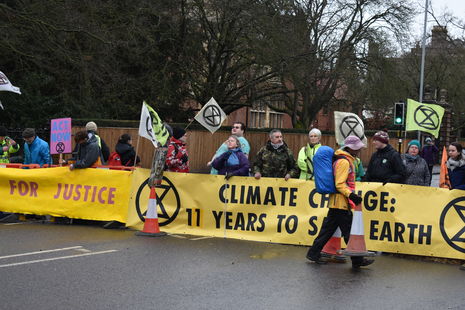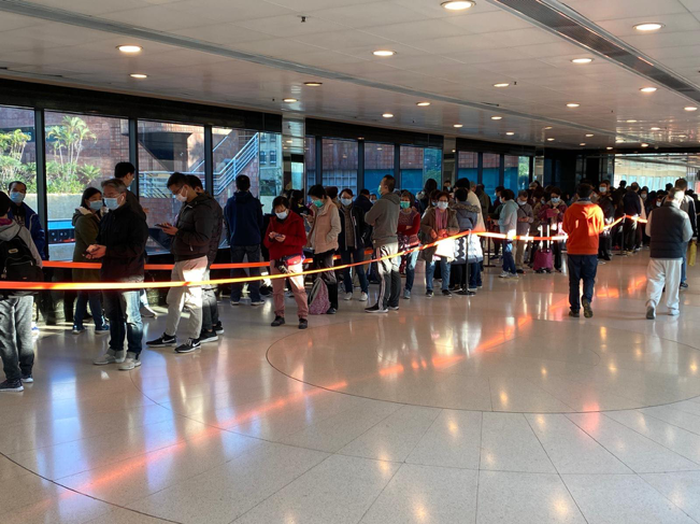Visiting Extinction Rebellion’s roadblock
“How did British protestors stack up with my own experiences in Hong Kong?” asks Issac Fung, as he considers the recent Extinction Rebellion roadblock

It was on a whim that I visited Extinction Rebellion’s (XR) roadblock on Saturday morning. Until that day, I had never paid much attention to Extinction Rebellion. None of my friends were involved with it; more to the point, their roadblock did not interfere with my daily commute to Sidgwick Site. My interest was only piqued after I saw Trinity College’s lawn, which was torn up earlier in the week by XR activists. The pristine-green grass, which had been cultivated by generations of gardeners, was scarred with holes and dug-up soil. Visitors shook their heads as they walked past it. I decided I had to find out more. How did British protestors stack up with my own experiences in Hong Kong?
Sauntering down Trumpington Street, I was greeted with a wall of barriers and traffic cones. Large banners displayed XR’s slogans (‘Climate Justice is Social Justice!’). Looking at their roadblock, I was reminded of Occupy Central, when thousands of pro-democracy protestors shut down Hong Kong’s financial centre in 2014. A battalion of protesters had set up a vast enclosure of tents, which in turn was defended by barricades bristling with defences. Student-volunteers set up stations dedicated for studying and revision; they also went around the site, picking up rubbish and organising recycling.
By contrast, XR’s roadblock was manned, at most, by two-dozen people. It was much smaller than Occupy Central, and much less impressive. I told myself that XR should be judged by the merits of their cause, and not by the number of supporters they commanded.
“Despite our differences, I could not help but see myself in the activists I was talking to.”
I also had to remind myself to slip out of old habits of thinking. The 2019 Hong Kong protests had instilled in me a sense of paranoia: the threat of violence had always loomed. This was why I could not help but cast a critical eye over XR’s blockade. Their roadblock, built around a roundabout, was vulnerable to attack from three directions. The flimsy barriers would be no good against a police charge. None of the volunteers seemed very alert to potential threats.
I had to remind myself that I was in Cambridge, not Hong Kong. There were no water cannons, no rubber bullets, and no tear gas. Unsuspecting protestors will not be ambushed by the riot police. If anything, the two constables hovering around the roadblock seemed rather bored. The protestors did not seem any livelier.
Still, XR’s activists were quick to answer my questions. They explained to me that their movement was highly decentralised, communicating over social media and the Internet. Smaller ‘affinity groups’ took charge in local protests. I felt like I was on familiar territory – their methods reminded me of how things were done back home.
They also told me that over a hundred people, all from different parts of the country, had travelled to Cambridge to help them set up their roadblock. ‘Where have they all gone?’, I asked, thinking about my earlier concerns. As it turns out, most of the activists went home after helping out. Numbers then dwindled from one 100 to 50; from 50, to 30. By the time I visited, only a few remnants of the original occupying force were left. Most of the tents were empty, and clusters of mosquitoes buzzed around the site. XR were right when they limited their roadblock to one week – they would not have lasted much longer than that.
Despite their fading momentum, many of the activists were perked up when they found out I was from Hong Kong. They wanted to make common cause. ‘Us lot, we protesters, we need to stick together, eh?’
There certainly were many similarities. For one, both protest movements have had to deal with fair-weather friends. Apparently, many angry Cambridgeshire residents withdrew their support from XR after having their commute delayed. This was exactly what happened in Hong Kong (‘I used to support democracy, but now your protests are making me late for work!’). Both movements have also had to deal with the bickering and splintering of internal factions. The principle of unity, or ‘no-splitting’, was something which all protest movements must struggle to sustain. Despite our differences, I could not help but see myself in the activists I was talking to. Protestors around the world, regardless of what they believe in, are united by the solidarity of opposition.
It was this solidarity of opposition which stopped me from leaping to conclusions. At a recent Cambridge University Conservative Association (CUCA) meeting, I heard the historian Andrew Roberts describe XR as ‘smug’ and ‘self-satisfied’. If I had never protested in Hong Kong, I would have agreed with him on the spot. But the activists I talked to at the roadblock were very reasonable. They seemed vulnerable, sympathetic – human.
I do not think I will come to agree with the aims of Extinction Rebellion any time soon. But I’ve learnt that I shared much more in common with them than I previously thought. My morning at the roadblock was a first step in finding that elusive common ground with the ‘opposition’. Not all political disagreements need to be fought out on the slopes of a barricade.
 Features / Should I stay or should I go? Cambridge students and alumni reflect on how their memories stay with them15 December 2025
Features / Should I stay or should I go? Cambridge students and alumni reflect on how their memories stay with them15 December 2025 News / Cambridge study finds students learn better with notes than AI13 December 2025
News / Cambridge study finds students learn better with notes than AI13 December 2025 Comment / The magic of an eight-week term15 December 2025
Comment / The magic of an eight-week term15 December 2025 News / News In Brief: Michaelmas marriages, monogamous mammals, and messaging manipulation15 December 2025
News / News In Brief: Michaelmas marriages, monogamous mammals, and messaging manipulation15 December 2025 News / Uni Scout and Guide Club affirms trans inclusion 12 December 2025
News / Uni Scout and Guide Club affirms trans inclusion 12 December 2025










